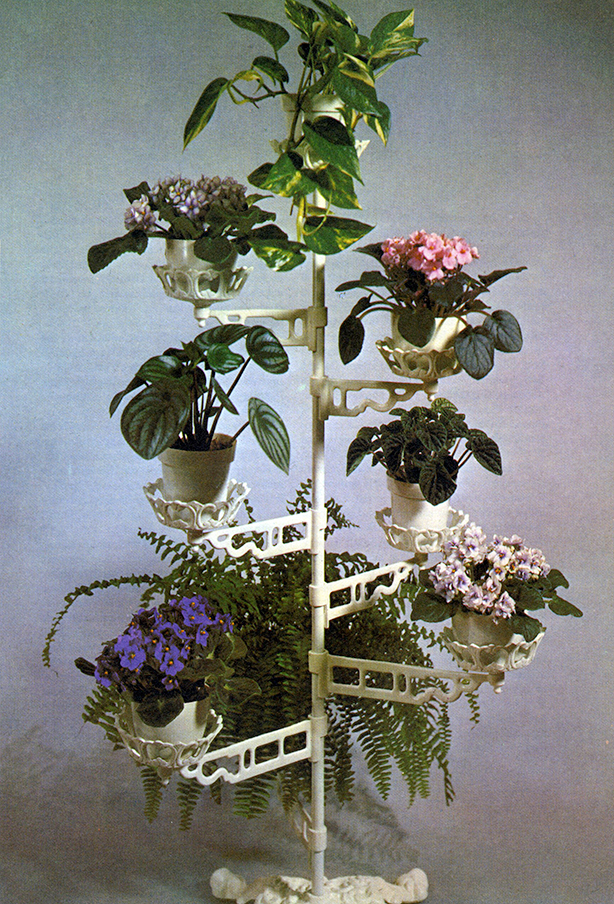WORD PROCESSOR: HIGHLIGHTS FROM THE COLLECTION
April 22, 2016
Indoor Plants
Aurora Tang
Indoor Plants by Helen Fleet (1977) is an illustrated guide to keeping and caring for indoor plants, which surged in popularity in the 1970s and seem to have proliferated in our increasingly indoor daily lives. They're everywhere.

Fleet ties the prevalence of indoor plants in the 1970s to trends towards open plan houses and offices, with large picture windows and lighter, brighter living conditions—evoking images of the grand planter-filled atriums of office buildings and hotels built around the time, like Frank Lloyd Wright's Marin County Civic Center in San Rafael, and John Portman's "ficus-filled Xanadus of flying walkways, spiraling stairs and cantilevered terraces"[1] of the Atlanta Hyatt Regency, Los Angeles Westin Bonaventure, and Detroit Renaissance Center. Fixtures in hotel lobbies, indoor plants may even occasionally make their way from the common areas into the guest rooms, where their presence is surprisingly effective in making the room feel more like a home, as I discovered on a recent business trip.
Indoor plants have been cultivated as guinea pigs in cultural experiments—in the visions of lush post-natural ecosystem bubbles promoted by Stewart Brand in his CoEvolution Quarterly, and later prototyped in Biosphere 2, and in the self-sustaining ecosystems designed by artists Helen Mayer Harrison and Newton Harrison.
They have played the villain in science fiction, appearing in works by H.G Wells, Arthur C. Clark, Roger Corman, and J.G. Ballard, in stories that sometimes contain plots involving frankenstein plant creations who turn against their human creators or keepers.
In television and the movies, potted plants can be spotted decorating the imagined outer space habitats of Logan's Run and Star Trek, living amongst the crew of the starship Enterprise[2]. In a synthesis of fiction and science, a species of bush tomato from Australia, Solanum watneyi, was recently named in honor of the film and novel The Martian's fictional protagonist Mark Watney, a botanist played by Matt Damon in the 2015 film, who is stranded on a space station and must learn to cultivate edible plants in space in order to survive[3].
They have been the subject of scientific space studies, too, beginning in 1982 with the Soviet space program's successful growth of the Arabidopsis (a plant related to mustard) on the Salyut 7 space station, in the first case of a plant flowering and producing seeds in space, and continuing on to space station Mir's 1997 SVET-2 Space Greenhouse program of seed to seed plant growth. Research and experiments on growing plants in space have continued on the International Space Station. Many of these studies concern the cultivation of edible plants in space, including NASA's VEGGIE system that involved growing lettuce, chard, radishes, cabbage, and peas on the ISS.
NASA's Clean Air Study, published in 1989, studied ways to clean the air on space stations, suggesting that several common houseplants, including the variegated snake plant (Sansevieria trifasciata 'Laurentii'), peace lily (Spathiphyllum 'Mauna Loa'), and money plant (Epipremnun aureum), are beneficial for their air purifying qualities, capable of naturally remove toxic agents such as benzene, formaldehyde, and trichloroethylene from the air.
Indoor plants even appear in the writings of Jean Baudrillard,[4]
The unspeakable house plants, lurking everywhere like the obsessive fear of death, the picture windows looking like Snow White's glass coffin, the glimpse of pale, dwarf flowers stretched out in patches like sclerosis...
And they appear in the local news,[5]
Indoor plants are universally loved, you'll see them in malls, public buildings, indoor gardens, offices and home windowsills, but too many die needlessly!
Today, indoor plants seem to be experiencing a new wave of popularity. "We're living in a houseplant renaissance," says Jesse Waldman of Pistils, a boutique nursery and garden shop in Portland, Oregon, in a feature in the April 2016 issue of Sunset Magazine. Waldman suggests "urban dwellers" are a big reason for the popularity of indoor gardening, such as the current internet craze of the kokedama ornamental moss ball bonsais. (A search for kokedama on Instagram brings up nearly 35,000 results.) House plants have become surrogates, or prerequisites, perhaps, for pets and children for these busy urbanites. "An indoor plant should require less attention than a goldfish, but more attention than polishing your dining table," advises an article in the November 5, 2015 issue of T Magazine.
In Indoor Plants, Fleet celebrates indoor plants as miracle workers in the home and office, for their ability to bring color, vibrancy, and joy to any indoor situations. Use them as attractive room dividers, light screens, and striking center pieces in the home, and in the office they can soften the harsh lines of file cabinets and draw attention away from piles of paperwork, improving worker morale and performance. "There is almost no argument that their presence is an aid to tidiness!"
Despite these praises, one can't help but sense something a bit sinister in these images of the indoor plant, suggestive of both the human ideal and demise. As long as humans have been living and working indoors, they have sought ways to tame and bring the outdoors inside with them. Indoor plants, these culturally engineered aesthetic constructs of nature, are complicated, quotidian reminders of man's desire for total control, of colonization, domestication, and technological sophistication—one wonders, have we reached peak house plant?
_________________________________________________________________[1] http://www.nytimes.com/2006/06/22/travel/22iht-hotdesign.html
[2] http://the-toast.net/2015/04/16/roving-plants-of-the-starship-enterprise/
[3] http://www.huffingtonpost.com/dr-chris-martine/why-im-naming-a-new-plant_b_8190242.html
[4] https://books.google.com/books?id=73CCg_I_rKsC
[5] http://www.fox9.com/good-day/garden-guy/69129355-story
Aurora Tang is a Los Angeles-based curator and researcher, with a focus on contemporary place-based practices. Since 2009 she has been Program Manager at the Center for Land Use Interpretation, a non-profit research and education organization dedicated to the increase and diffusion of knowledge about how our nation's lands are apportioned, utilized, and perceived. She has also worked with The Getty Conservation Institute, The Getty Research Institute, and High Desert Test Sites, where she served as Managing Director from 2011-2015.
View Indoor Plants in the catalog here.
